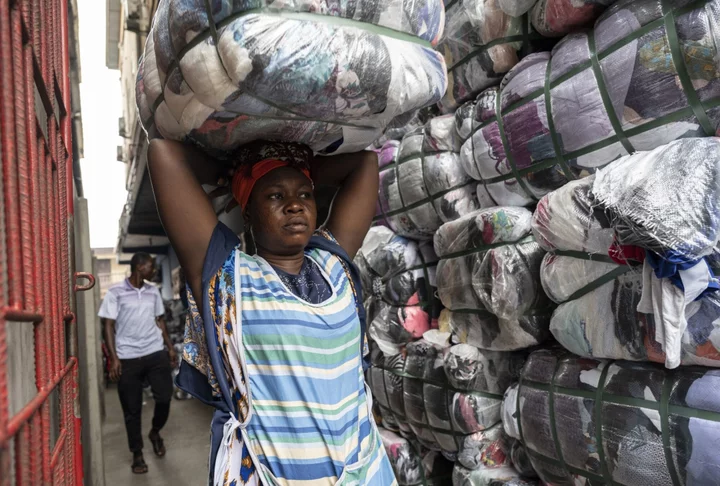Regulators in the US and Europe are waking up to the mounting clothing waste problem that’s clogging local landfills and overwhelming countries such as Ghana and Chile. Increasingly, they’re asking brands to pay for it.
Under rules that have been separately proposed in California, New York, Sweden, the Netherlands, and Italy — and are also under discussion in the UK and EU — fashion companies would have to fund textile recycling programs, in most cases by paying for the volume of clothing they produce. These “extended producer responsibility” (EPR) schemes, modeled after programs for other hard-to-recycle goods such as batteries, mattresses and medical sharps, require brands to pay fees based on their product output, or to set up their own recycling programs.
Fashion industry waste is a growing and largely unchecked problem. In the EU, textile waste totals about 4 million tons each year, while in the US it hit 17 million tons in 2018, up 80% over 2000. Garments that don’t end up in local landfills are often shipped in bulk to countries in the Global South. In Ghana, as many as 15 million discarded garments arrive every week, according to the Or Foundation, which advocates for fashion waste reform.
EPR regulations aim to make fashion brands part of the solution. “It’s forcing businesses to consider their footprint and getting them to think top to bottom and ask themselves, ‘How much do we need to be producing and how do we make sure we don’t have to pay for it on the backend?’” said Betina Baumgarten, a fashion law attorney and consultant at Fashion CUTS.
Read More: The Global Glut of Clothing Is an Environmental Crisis
Supporters of EPR programs for textiles hope they will curb overproduction, lead to recycling innovations and encourage companies to make higher-quality products. It’s also likely that EPR fees would be passed on to consumers, whose thirst for cheap clothing is exacerbating overconsumption. But price increases would “have to be quite significant” to curb serial shopping, said Nusa Urbancic, campaigns director at the Changing Markets Foundation.
In most places considering textile EPR programs, fees are still being debated. But France is indicative: The country has had a program in place since 2007, which bases each company’s financial obligation on the quantity of goods it produced in the preceding year. Products are bucketed into 107 categories — from clothing to footwear to household linens — and further segmented by weight. In 2021, more than 6,000 brands were included, and paid a collective €51 million ($55 million) in fees across 2.8 billion items. That averages out to around €8,500 ($9,242) per company, or €0.16 ($0.17) per garment.
The Or Foundation says fees should begin at $0.50 per garment and go up to at least $2.50 based on the item’s cost to reuse and recycle, and the impact of its decomposition. Lower fees, like those levied in France, “are far too low to be impactful on any level,” said Liz Ricketts, the Or Foundation’s co-founder and director. The French government has conceded that its fees are too low; in November, it ordered the group that executes the EPR program to propose new pricing criteria.
In California and Connecticut, the success of EPR programs for mattresses suggests these schemes can divert a significant amount of waste. In Connecticut, where EPR fees run companies $11.75 per mattress, an estimated 76% of discarded mattresses are recycled. In California, which charges companies $10.50 per mattress, 1.6 million mattresses were recycled in 2021, resulting in the recovery of 90 million pounds of materials.
Fashion companies have already started to mobilize around their own resale programs, or selling used goods through platforms like ThredUp Inc. Many EPR policies would also require companies to collect used garments, including a scheme that will go into effect in the Netherlands in July. Apparel-makers like Levi Strauss & Co., Madewell Inc., Zara (owned by Inditex SA) and Hennes & Mauritz AB have been running voluntary take-back programs for years, but not at a scale large enough to curb overall waste.
“[These] are largely isolated efforts to capture the economic value of high-quality clothing, leaving other textile products and materials entirely unaddressed,” the Ellen MacArthur Foundation noted in a 2022 paper. “We need a collective system and infrastructure to capture the value of used textiles.”
Textile recycling has obvious appeal, but modern clothing — made of thousands of material blends that include polyester, elastic, cotton, linen and silk — is notoriously difficult to recycle. Sorting and processing used clothes is expensive and labor-intensive, and the technology needed to recycle garments made from blended fibers is still in its infancy. That means many clothes turned in for “recycling” are in fact downcycled into insulation or shredded for rags.
Some brands see EPR legislation as a cost-sharing mechanism that would help scale recycling solutions, said Joanne Brasch, special project manager at the California Product Stewardship Council, which helped craft a textile EPR bill now under consideration in the state. That measure contains grants and research funds to support new recycling technologies. H&M endorsed the bill, saying it wants to use 100% recycled or sustainably sourced materials by 2030, but many such materials “are not yet commercially available or even invented.”
Lululemon Athletica Inc. recently partnered with Sydney-based Samsara Eco to turn apparel waste into recycled nylon and polyester. Evrnu, a Seattle-based material innovation company, is also working on converting clothing waste into yarns for new fabrics. Its first product — Nucycl, made from discarded textiles with 98% cotton content — is already used by Zara and Pangaia.
But converting clothing with high levels of polyester into new fabrics is both pricey and technologically challenging, and risks exacerbating microplastic pollution. “The amount of capital is sizable to invent new solutions,” said Evrnu Chief Executive Officer Stacy Flynn. “Brands don’t have the checkbooks to invest. We don’t have an innovation pipeline in the apparel industry to solve for the scope of the problem.”
EPR programs would also improve the landscape for recycling companies that sort and recirculate textiles, said Chloe Sonder, co-founder and CEO of SuperCircle, which helps companies manage their textile waste. These operations need a large amount of material to make the process economical. While tiny bits of cotton from underwear or T-shirts are difficult to aggregate, EPR programs could help recyclers pull in more cast-offs.
EPR advocates say these programs have an upstream impact as well. Resale, rental and repair helps ensure garments are worn more times before entering waste streams, but brands have to “rethink how they design clothing in order to scale reuse and recycling in a cost-effective way,” said Rachel Kibbe, executive director of the American Circular Textiles Group, which is pushing for policy regulation in the textile industry.
Better product design, improved sorting mechanisms and more recyclable materials would in turn help address the burden shouldered by countries in the Global South, where much of what enters the secondhand textile trade ends up as environmentally hazardous waste. At the moment, though, countries receiving and managing clothing collected through EPR programs receive no financial support from those funds.
“If anything is proven by the waste crisis we see here in Accra every day, it is that clothing exists on our planet in absurd excess,” said Ricketts of the Or Foundation. “It will be a monumental undertaking to repair the ecological damage, and that’s what we are here for.”









